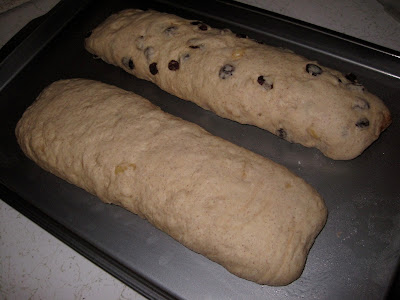Friday, December 24, 2010
Stollen (German Christmas Bread)
In light of my recent interest in bread baking, my curiosity was piqued when I came across a recipe for Stollen. It's traditional German Christmas bread, I'm German, and I like to bake stuff. Decision made.
After some Wikipedia-ing, I discovered that Stollen usually has nuts, in addition to the traditional fruit and spices. A few more searches led me to this similar adaptation of Peter Reinhart's original recipe and the Food Network's version of Stollen. I decided to make a slight combination of the three versions, using the basic Peter Reinhart recipe, that would also include a cinnamon-sugar filling (because I'm a sucker for anything cinnamon-sugar). The one catch? I really don't like dried fruit of any kind and was tempted to leave it out entirely. Let's not address how ridiculous that is considering that fruit is a critical element of Stollen, but eventually I compromised by baking one loaf with raisins and one without.
The verdict? Since the directions didn't specify an exact time and I lack a thermometer, I over-baked my loaves slightly, making them a little too dry. As expected, I greatly preferred the loaf without the raisins, but my dad seemed to like the more traditional take. Making this was a lot of fun, but next time I think I'll stick to some kind of cinnamon bread!
Recipe adapted from The Bread Baker’s Apprentice by Peter Reinhart, with some modifications
For the sponge:
1/2 cup whole milk (I used 2%)
1/2 cup flour
4-5 tsp active dry yeast (two packets)
For the fruit, if desired (this will make enough for half the dough):
2/3 cup raisins
1/4 cup bourbon
1/2 Tbsp lemon extract
For the dough:
2 1/4 cups flour
1 Tbsp sugar
3/4 tsp salt
1 tsp ground cinnamon
1 egg
5 Tbsp unsalted butter, at room temperature
1/3 cup water
1/2 cup almond slivers
For the filling:
3 Tbsp melted butter (I just used the rest of the stick)
2-3 Tbsp Sugar
2 tsp ground cinnamon
For the topping:
Leftover melted butter
Powdered sugar
Directions:
To make the sponge, warm the milk to about 100 degrees and then whisk in the flour and yeast. Cover with plastic wrap, and let sit for an hour or until the sponge is very foamy.
Combine the fruit with the liquor and lemon extract, and set aside.
To make the dough, whisk together the flour, sugar, salt, and cinnamon. Stir in the egg, butter, sponge, nuts, and enough water to form a soft but not sticky ball (this should take about 2 minutes). Once the dough comes together, cover the bowl and let the dough rest for 10 minutes.
At this time, separate the dough in half if only making one loaf with fruit. Knead the fruit into half the dough, and then transfer the dough to a floured surface. Continue kneading both balls of dough for approximately 6 minutes or until the dough feels soft (not sticky).
Spray a bowl with cooking spray and then transfer the dough balls to the bowl. Roll to coat and then cover the bowl with plastic wrap. Let rise for 45 minutes – it should rise some, but it shouldn’t double in size.
When ready, move the dough balls back to the floured surface. Make the cinnamon-sugar mixture by whisking the two together. Pat the dough down into rectangles, brush with melted butter, and sprinkle with cinnamon-sugar. Fold the bottom third of the dough letter style up to the center, and press to seal. Fold the remaining dough over the top and seal the seam.
Once shaped, move to a large greased baking sheet. Cover the loaves with a damp towel, and let rise about an hour or until the dough is 1 1/2 times the original size. Preheat the oven to 350 degrees.
Bake the loaves for 20 minutes. Rotate the pan 180 degrees, and then continue to bake 20-50 minutes longer, depending on the sizes of the loaves. The temperature should register 190 degrees in the center of the loaves when finished. After you remove them from the oven, brush the loaves with melted butter while they are still hot, and then sprinkle a layer of powdered sugar over the top. Wait one minute, and then sprinkle on another layer.
Subscribe to:
Post Comments (Atom)








No comments:
Post a Comment